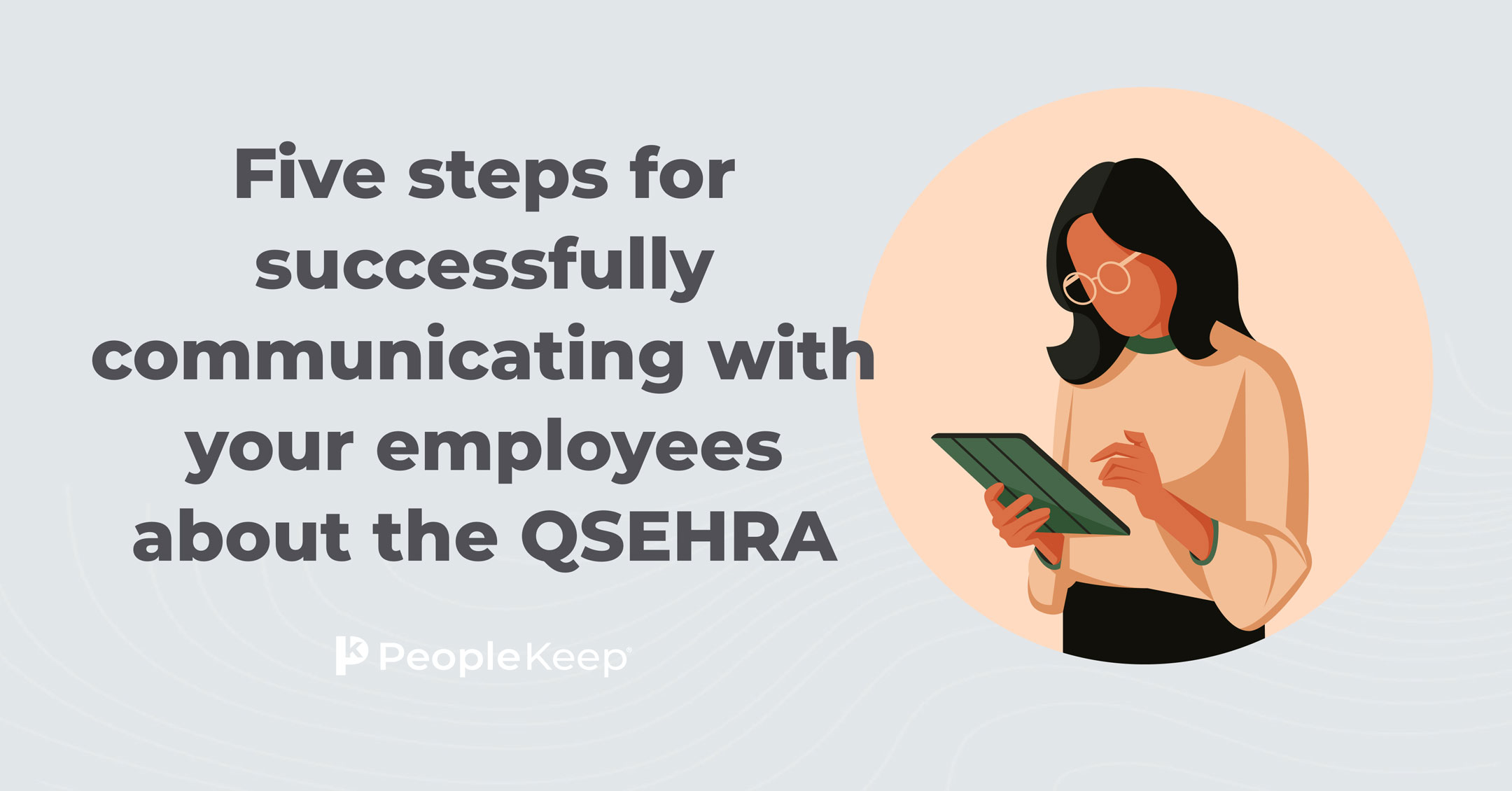How to set up a qualified small employer HRA (QSEHRA)
By Holly Bengfort on June 12, 2025 at 2:30 AM
As a small business owner, it can be challenging to offer competitive employee benefits that attract and retain top talent. The rising costs of traditional group health plans make it even more difficult.
The qualified small employer health reimbursement arrangement (QSEHRA) is a flexible and cost-effective alternative to group health coverage. With the QSEHRA, small employers can offer their employees tax-free reimbursements for their individual health insurance premiums and medical expenses.
In this article, we'll walk you through the steps required to successfully offer a QSEHRA, ensuring that both you and your employees benefit from this innovative approach to health benefits.
In this blog post, you'll learn:
- Employer and employee eligibility for the QSEHRA.
- Which medical expenses are eligible for reimbursement.
- How PeopleKeep by Remodel Health can help you offer a QSEHRA.
Benefits of the QSEHRA
Several aspects of the QSEHRA make it an attractive option to small business owners.
With the QSEHRA, they can:
- Have complete cost control. Employers have complete control over their benefits costs with a QSEHRA. They set allowances for their employees and only reimburse them up to that amount. Plus, unused funds stay with them at the end of the plan year.
- Enjoy tax benefits. They offer their employees money for healthcare expenses on a pre-tax basis.
- Empower employees. Instead of lumping employees together into a one-size-fits-all group health plan, employers can offer them the flexibility to choose their own medical plans, enhancing employee satisfaction within the organization.
How to successfully set up a QSEHRA
Offering a QSEHRA can be a game-changer for small businesses looking to support their workforce with medical costs. Follow these nine steps to successfully set up a QSEHRA.
1. Make sure you're an eligible employer.
To offer a QSEHRA, your organization must have fewer than 50 full-time equivalent (FTE) employees. If an organization has 50 or more FTEs, it's considered an applicable large employer (ALE) under the Affordable Care Act (ACA). This means you can offer an individual coverage HRA (ICHRA), but not a QSEHRA. Unlike the QSEHRA, employees need qualifying individual health insurance coverage to participate in the ICHRA.
In addition to meeting the company size requirement, an eligible employer can't offer a QSEHRA in conjunction with any other group plan. Employers who currently provide a group health insurance policy can cancel it if they want to offer a QSEHRA in its place. Otherwise, they can look into a group coverage HRA (GCHRA). The GCHRA works alongside group health coverage.
2. Choose how to administer your benefit.
You could try to self-administer your QSEHRA. But, with all the compliance pitfalls and potential mistakes, it’s better to enlist the help of a plan administrator, like PeopleKeep by Remodel Health. PeopleKeep saves you the hassle of going it alone. Our QSEHRA administration software automates the entire process.
We make offering a QSEHRA easier by:
- Creating and updating formal plan documents to ensure compliance with state and federal regulations.
- Ensuring that employees receive all necessary notices and providing support for employee communication.
- Reviewing reimbursement requests from your employees for their eligible out-of-pocket costs. This keeps your benefit HIPAA and IRS compliant.
- Reminding you of important deadlines, like filing Form 720 and paying PCORI fees each July.
- Providing award-winning customer support when you need it.
3. Determine employee eligibility requirements.
Employers must offer a QSEHRA to all full-time employees. Employees’ spouses and legal dependents can also use the employees’ allowance. Employers may also choose to include part-time workers, but they must offer them the same monthly allowance as full-time employees. 1099 employees aren't eligible for the QSEHRA.
The IRS 1 permits employers to exclude some employees, such as:
- Part-time employees
- Seasonal employees
- Employees who haven't been with the employer for at least 90 days of service
- Workers who are younger than 25 at the start of the plan year
- Union employees, if health benefits were the subject of good-faith bargaining
- Nonresident aliens with no income from U.S. sources
Even employees covered under a parent's or spouse's group health insurance policy can use QSEHRA funds for their medical expenses as long as it provides minimum essential coverage (MEC). Employees without MEC can’t use their QSEHRA allowances.
4. Set your reimbursement limits.
Next, it's time to decide how much you'll offer your employees to reimburse their out-of-pocket medical costs and health insurance premiums. You can customize monthly allowances based on employee age and family status.
According to our 2025 QSEHRA Report, small businesses offered an average monthly allowance of $442 in 2024. That's a 2.55% increase from 2023’s average of $431.
There's no minimum employer contribution with the QSEHRA, so you can offer the benefit to your employees even on a small budget. But the IRS does set an annual limit for maximum employer contributions that changes every year. For 2026, the maximum annual allowance is $6,450 for single employees and $13,100 for employees with families.
5. Decide what out-of-pocket healthcare costs are eligible for reimbursement.
Eligible employees can use their QSEHRA allowance for more than 200 eligible medical expenses.
QSEHRA-eligible expenses include:
- Monthly premiums for health, vision, and dental plans
- Vision and dental care expenses
- Doctor visits
- Prescription drugs
- Over-the-counter medication
Employers can also offer a premium-only QSEHRA that only covers health insurance premiums for eligible employees.
6. Pick a start date.
With a QSEHRA, you don't need to wait for an enrollment period to get started. If your company doesn't have any type of health plan in place, you can begin your QSEHRA as soon as you want. If you already have a plan, you'll need to cancel it before the date you want the QSEHRA to start.
Keep in mind that starting your benefit plan year on the first of the month makes calculating monthly allowances for QSEHRA funds easier. If you offer a QSEHRA for less than 12 months, the contribution limit is prorated.
7. Establish your legal documents.
It's critical to comply with both IRS and U.S. Department of Labor rules regarding legal plan documents for the QSEHRA.
QSEHRA plan documents must include detailed information about the benefit you're offering to comply with federal regulations. Your plan document package should explain your new plan and coverage details and instruct employees to inform their insurer of their QSEHRA allowance.
It's also important to note that reimbursements are only tax-free to your employees if they have a health insurance plan that meets MEC. If you mistakenly reimburse an employee who doesn't have MEC, they may need to pay back their reimbursement or pay taxes on that amount.
Companies that fail to follow the rules face significant penalties. An administrative software solution, like PeopleKeep by Remodel Health, automates this for you and ensures your plan stays up to date with the latest regulations.
8. Tell your employees about their new benefit.
If your employees don't know a new health benefit is available, they're far less likely to use it. Make sure your workers are aware of your QSEHRA, and give them the information they need to take advantage of it.
According to the IRS2, employers should give eligible employees a written notice at least 90 days before the QSEHRA starts. Non-eligible employees must also receive the notice if they become eligible for the plan.
If you fail to provide the notice on time, you could face a penalty1of $50 per employee up to a maximum of $2,500 for the calendar year.
9. Help your employees find health insurance coverage.
If your employees don't have qualified health plans already, you should help them with their coverage.
Even though you can't point them toward a particular insurance company, you can be a valuable source of information and support. You can direct employees to your state's health insurance exchange or the federal Health Insurance Marketplace to get started. From there, they can review their health insurance options and select the policy that works best for them.
When you offer a QSERHA through PeopleKeep by Remodel Health, it's easier for your employees to find health coverage. They can shop for health plans and ancillary policies directly from their accounts. Through our platform, they can compare health policies based on network type, metal tier, and carrier to help them make an informed decision.
Additionally, it's important for your employees who receive premium tax credits to know how the QSEHRA affects them. They can only collect premium tax credits if their QSEHRA allowance isn't considered affordable3.
Learn more about the QSEHRA and premium tax credits in our article.
Conclusion
The qualified small employer health reimbursement arrangement (QSEHRA) is an excellent alternative to traditional group health insurance. It's a tax-free employee benefit that helps cover qualified medical expenses in a way that offers budget control to small business owners.
Setting up a QSEHRA on your own is easier with this step-by-step guide. However, administering it yourself can be a tedious task. PeopleKeep by Remodel Health's QSEHRA administration software can save you valuable time while keeping you compliant.
This post was originally published on March 9, 2017. It was last updated on June 12, 2025.
Check out more resources
See these related articles

2026 QSEHRA contribution limits
Small businesses offering a QSEHRA must follow specific allowance cap guidelines. For 2026, employers can offer up to $6,450 for self-only employees.

5 questions businesses with employees in multiple states should ask about health benefits
Businesses with employees in multiple states often struggle to insure all their employees. Fortunately, there are other options than group health insurance.

5 steps for successfully communicating with your employees about the QSEHRA
Need help communicating your QSEHRA notice to employees? This guide provides five steps to communicate the benefits and requirements of the QSEHRA.



